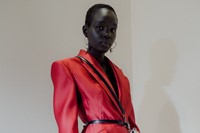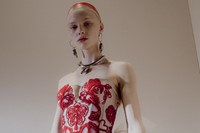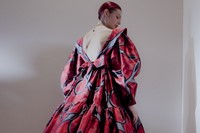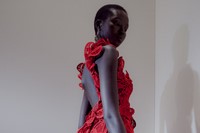For her Autumn/Winter 2020 collection for Alexander McQueen, Sarah Burton drew inspiration from Wales’ “artistic and poetic heritage, by its folklore and the soul of its craft”
Alexander McQueen was – and is to this day – celebrated for his extraordinary blend of subversion and tradition; of artistry and technical ability. Trained on Savile Row, the age-old centre of British menswear tailoring, he took traditional craft techniques, such as embroidery, lace making and metalworking and wove them, sometimes literally, into his highly original designs.
The same can be said for Sarah Burton – the once design team assistant, then head of womenswear and, following McQueen’s death in 2010, creative director of the brand – whose collections are the result of exceptional, sometimes endangered craft techniques, many of them native to the British Isles.
Burton’s Autumn/Winter 2020 offering, presented in Paris on Monday, was no exception. Speaking backstage after the show, the designer revealed that the story of this collection began in Wales, specifically at St Fagans National Museum of History in Cardiff, an institution devoted to chronicling the life, culture, and architecture of the Welsh people.
Here, she encountered the Wrexham Tailor’s Quilt, also known as The Wonder Quilt of Wrexham, an 1842 patchwork coverlet made from 4,525 pieces of coloured woollen cloth which took its creator – the master tailor James Williams – over ten years to complete. Cited as one of the few surviving examples of the fashion among highly skilled tailors during the mid-19th century, the quilt depicts Biblical scenes, Welsh landmarks, motifs symbolising the four nations of the United Kingdom, as well as other countries. To Burton, this object represented “a narrative of someone’s life”.
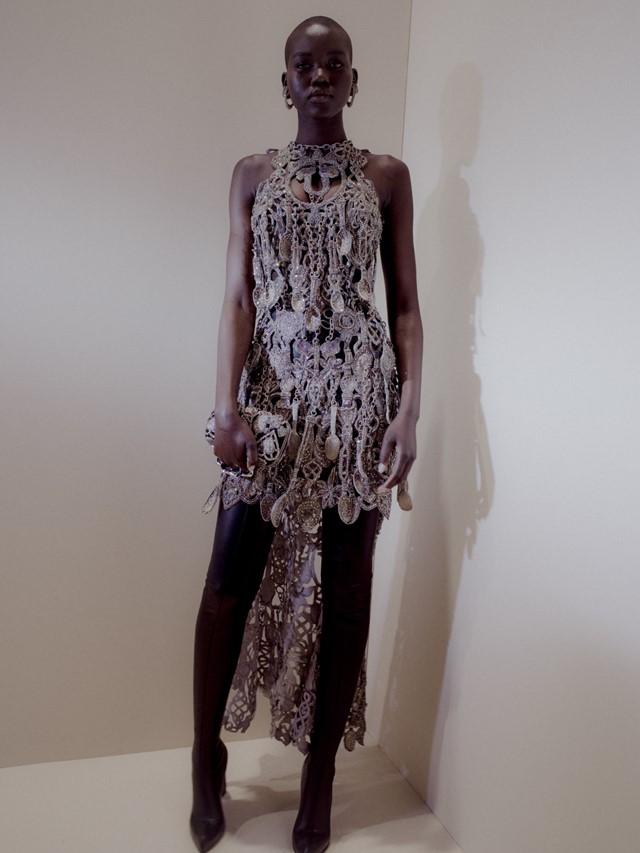
Imagery from this quilt was transposed into prints and intarsia – particularly imagery pertaining to the industrial revolution, like viaducts, steam trains and sailing ships – while other references to Welsh life and culture resounded thoughtfully throughout the rest of the collection. Looking to McQueen’s Spring/Summer 2004 Deliverance collection, which also incorporated quilts, as well as the collection of the Welsh quilts and blankets dealer Jen Jones, coats and dresses drew on traditional Welsh shawls and blankets, further evoking a sense of safety and comfort, while checks borrowed from the colours and geometric motifs of traditional Welsh costume.
Soundtracked by readings from the works of seminal Welsh poet Dylan Thomas, there were even references to the national flower of Wales, the daffodil, and the traditional ‘love spoon’ – the earliest example of which is also housed in the St Fagans National History Museum. One of the final dresses was encrusted with a love-spoon embroidery (“a symbol of togetherness, of being there for others,” said Burton) in bullion, crystal, metal thread work, sequins and beads – paying homage to the exceptional technical ability of the house’s artisans.
This was, however, a collection of juxtaposition: for all the softness of the blanket coats, wool flannel and wool cashmere, there was a hardness in the black leather bodices and corset harnesses; a sharpness in tailoring and straight-legged trousers cut from satin and silk. The McQueen woman may possess a sense of safety and comfort, but she is also “courageous, grounded, bold: heroic,” according to Burton. “The collection is a love letter to women and to families, colleagues and friends. We went to Wales and were inspired by the warmth of its artistic and poetic heritage, by its folklore and the soul of its craft.”

